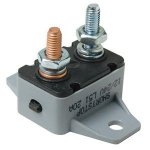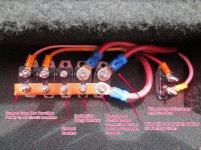Still in my first full season in my Sundance XLT, so I'm learning a lot. There is one thing I've noticed that puzzles me; hopefully some of the experts out there can chime in.
I have the WFCO 8900 series converter and two GC batteries in series. I had the coach sitting at home, not plugged in, so it was just slowly draining the batteries. I had a trip coming up so I went to charge the batteries by plugging in the coach to shore power. As I was working around the unit, I heard a slight clicking noise; I found it to be one of the little circuit breakers by the battery pack. I went inside the coach to see what the battery monitor was showing. It was at 65% capacity or so; when I checked the current draw, I saw the current go to around 17-18 amps (charging), at which time it reversed and went to zero for a few seconds, then repeated. I'm assuming that the breaker is heating up when the high-current is going through it, tripping, then resetting when it cools, starting the cycle again. (Must be an automatic breaker...?)
This seems abnormal to me. Does the WFCO converter not limit the current when charging the battery? Or is it supposed to and my converter is just not operating properly? As it stands, I cannot dry camp for any length of time and then plug in to charge my batteries with the converter (which is why I bought the GC batteries to begin with!). I can plug in a regular battery charger directly to the batteries, but it doesn't seem like I should have to do that.
Is a Progressive converter in my future?
Thanks for any light anyone can shed (if you'll pardon the bad pun...).
Brian
I have the WFCO 8900 series converter and two GC batteries in series. I had the coach sitting at home, not plugged in, so it was just slowly draining the batteries. I had a trip coming up so I went to charge the batteries by plugging in the coach to shore power. As I was working around the unit, I heard a slight clicking noise; I found it to be one of the little circuit breakers by the battery pack. I went inside the coach to see what the battery monitor was showing. It was at 65% capacity or so; when I checked the current draw, I saw the current go to around 17-18 amps (charging), at which time it reversed and went to zero for a few seconds, then repeated. I'm assuming that the breaker is heating up when the high-current is going through it, tripping, then resetting when it cools, starting the cycle again. (Must be an automatic breaker...?)
This seems abnormal to me. Does the WFCO converter not limit the current when charging the battery? Or is it supposed to and my converter is just not operating properly? As it stands, I cannot dry camp for any length of time and then plug in to charge my batteries with the converter (which is why I bought the GC batteries to begin with!). I can plug in a regular battery charger directly to the batteries, but it doesn't seem like I should have to do that.
Is a Progressive converter in my future?
Thanks for any light anyone can shed (if you'll pardon the bad pun...).
Brian


